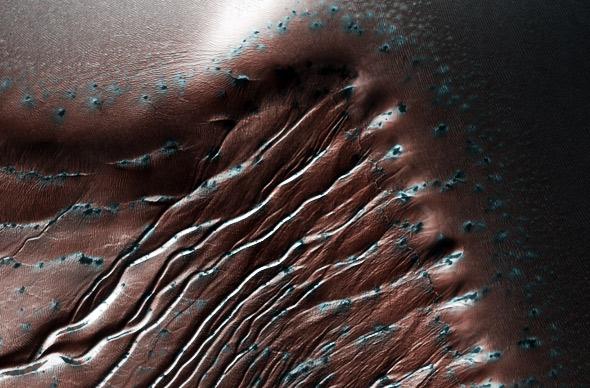By now, many of you have heard about some big announcement NASA is about to make about Mars. The news is embargoed until the press conference Monday (which you can watch live at 11:30 EDT), but of course speculation is rampant, especially since the press release says it’s a “major science finding.”
In the email NASA sent out, the names of some panelists were given: Alfred McEwen, Lujendra Ojha, and Mary Beth Wilhelm. McEwen is the principal investigator for the wonderful HiRISE camera on the Mars Reconnaissance Orbiter. Ojha studies recurrent features on Mars that look very much like they were carved from water, like gullies down the sides of craters. Wilhelm studies many things, including the habitability of ancient Martian terrain.
As many people have pointed out on social media, at a European planetary science conference on Monday, McEwen and Ojha are presenting results of a study showing that seepage in crater walls appears to be seasonal, and most likely due to water. Not only that, but Ojha and Wilhelm are presenting results that show the presence of salts in crater wall gullies, too, implying strongly they are due to water leakage.
I’m posting this now to hopefully extinguish rampant speculation (what I write here is based on evidence, so call it mild speculation). I assume these new results will be a major part of the news conference, but there might be more as well.
I also wanted to give a little bit of background on these gullies, since they’re pretty cool. As far back as 2007, NASA announced they might be from water, though a year later a study was released indicating many might be better explained as dry grains flowing downhill. In 2010 more gullies popped up that looked like they could be from liquid flowing, but the evidence was still a bit circumstantial. We know water once flowed on Mars, a long time ago, and there’s plenty of evidence for ancient standing lakes and even oceans. Also, even now there’s lots of water ice just below the surface across a wide range of latitudes, too.
Salty water melts at lower temperatures than fresh water, so if that’s what lurks behind crater walls, then in the spring sunlight can warm the ground and cause seepage. The results being presented at the European conference question the idea of water ice under the surface being the cause, and suggest it may be from deliquescence; absorption from the atmosphere in the ground until the water can break through. That seems unlikely, but we’ll get more info during the press conference.
Mind you, as of right now we have never seen any evidence for the presence of extant liquid water on Mars. Even the temporary existence of water in a liquid state is scientifically interesting, even exciting. However, it’s also been found that a type of chemical called perchlorates is widespread in Martian soil, which makes the hunt for life a bit more of a problem. I expect that will come up in the press conference as well.
I’ll be listening in and will write up the news as soon as I can. Stay Tuned.
In the meantime, because why not, here’s my Crash Course Astronomy episode on Mars. Enjoy!
*Correction, Sept. 28, 2015: In the caption of the photo, I originally misspelled Russell.
